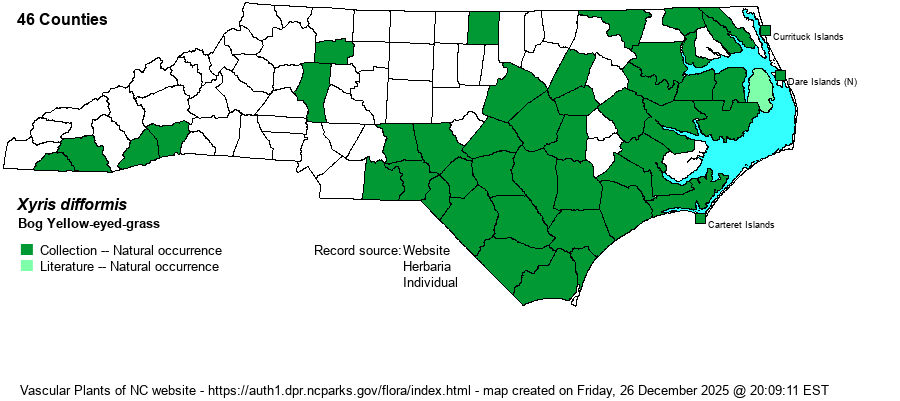| Section 5 » Order Commelinales » Family Xyridaceae |
Show/Hide Synonym
| taxonName | relationship | relatedTaxonName | relatedTaxonRefText | relComments |
|---|
|
|
|
|
| Xyris difformis | = | Xyris difformis var. difformis | Gleason and Cronquist (1991) | | | Xyris difformis | = | Xyris difformis var. difformis | Flora of North America (1993b, 1997, 2000, 2002a, 2002b, 2003a, 2004b, 2005, 2006a, 2006b, 2006c, 2007a, 2009, 2010) | | | Xyris difformis | = | Xyris difformis var. difformis | Godfrey and Wooten (1979, 1981) | | | Xyris difformis | = | Xyris difformis var. difformis | Kartesz (1999) | | | Xyris difformis | = | Xyris difformis var. difformis | Kral in Kubitzki (1998b). Key adapted from X, GW, and Z. | | | Xyris difformis | < | Xyris difformis | Fernald (1950) | | | Xyris difformis | < | Xyris difformis | Gleason (1952) | | | Xyris difformis | < | Xyris difformis | | | | Xyris difformis | < | Xyris difformis | Radford, Ahles, and Bell (1968) | | | Xyris difformis | < | Xyris difformis | Small (1933, 1938) | | | Xyris difformis | < | Xyris difformis | Wofford (1989) | (also see X. curtissii) | | Source: Weakley's Flora |
|
| Author | Chapman | |
| Distribution | Mostly Coastal Plain and Sandhills; scattered records in the Piedmont and southern Mountains.
Southern ME to southern Ont., south to north peninsular FL and eastern TX. | |
| Abundance | Frequent in the Coastal Plain and Sandhills, rare elsewhere in the Piedmont and southern Mountains. Considering that it has been collected in all but a handful of Coastal Plain counties, the State Rank of S3S4 is quite conservative; S4S5 seems more appropriate. | |
| Habitat | Pond and impoundment margins, beaver ponds, wet pine savannas and flatwoods, montane seepage bogs. In the Sandhills also on shores of blackwater streams. | |
| Phenology | Flowering and fruiting late July-October. | |
| Identification | In Bog Yellow-eyed-grass the scape (stem) broadens and flattens in the upper 1-3 inches (be sure to check several scapes). Our other species may broaden slightly immediately below the head, but not as much as half an inch. Scapes reportedly reach 2 feet tall (Godfrey & Wooten 1979), but NC material is seldom more than about 1 foot. Leaves are broadly linear, up to a foot long, and pinkish at the base. Scapes of Irisleaf Yellow-eyed-grass (X. iridifolia) may be somewhat flattened, but it is a more robust plant, with wider leaves and longer heads (mostly 20-25 mm vs. 8-15 mm in S. difformis). See also the more robust Small's Yellow-eyed-grass (X. smalliana). | |
| Taxonomic Comments | Formerly, X. curtissii was treated as a variety of X. difformis, even though stems are not flattened.
Members of Xyris are easy to identify to genus, but can be a challenge to identify species. Careful observation of a few features with a hand-lens is usually sufficient. Close attention must be paid to the flowering head, which is composed of overlapping brown scales. Immediately behind each scale are two brown "lateral sepals"; the margins of these may be feathery or irregularly lacerate (cut into narrow segments) or finely cut into short, comb-like prickles. Lateral sepals may be hidden or a bit longer than each scale. The flowers themselves are usually of little diagnostic value, other than time of flowering -- morning vs. afternoon. Seed size and ornamentation can also be useful characters, but require a dissecting scope to see well. Note also whether leaves and scapes (stems) are twisted and the color of the basal portion. All species have 2-ranked leaves, but in some species the leaves are arranged in a broad, fan-like shape. Finally, note the leaf and stem surface texture -- whether smooth of with little pale bumps. See Godfrey & Wooten (1979) for detailed descriptions and drawings. | |
| Other Common Name(s) | Flatstem Yellow-eyed-grass | |
| State Rank | S3S4 [S4S5] | |
| Global Rank | G5 | |
| State Status | | |
| US Status | | |
| USACE-agcp | OBL link |
| USACE-emp | OBL link |

